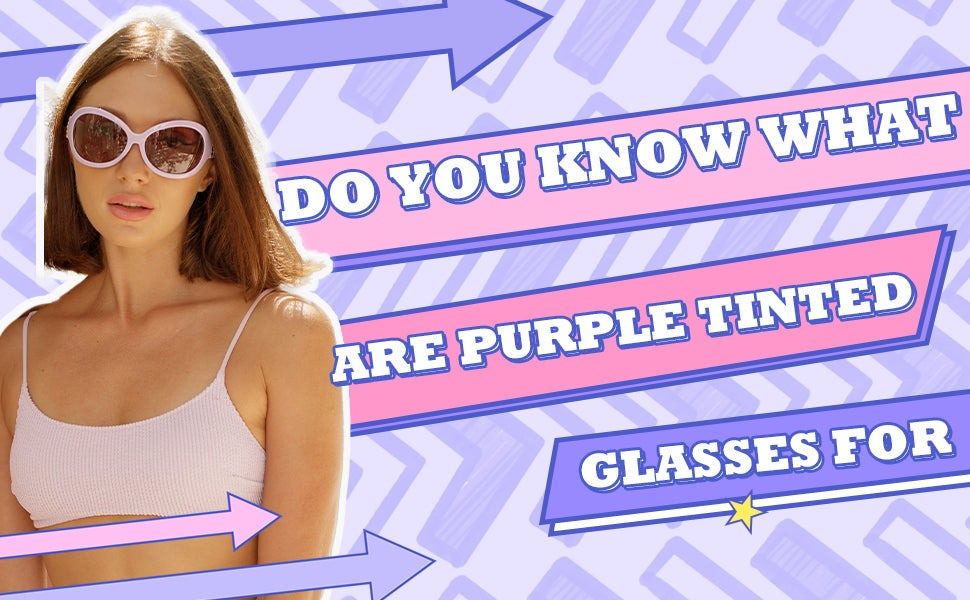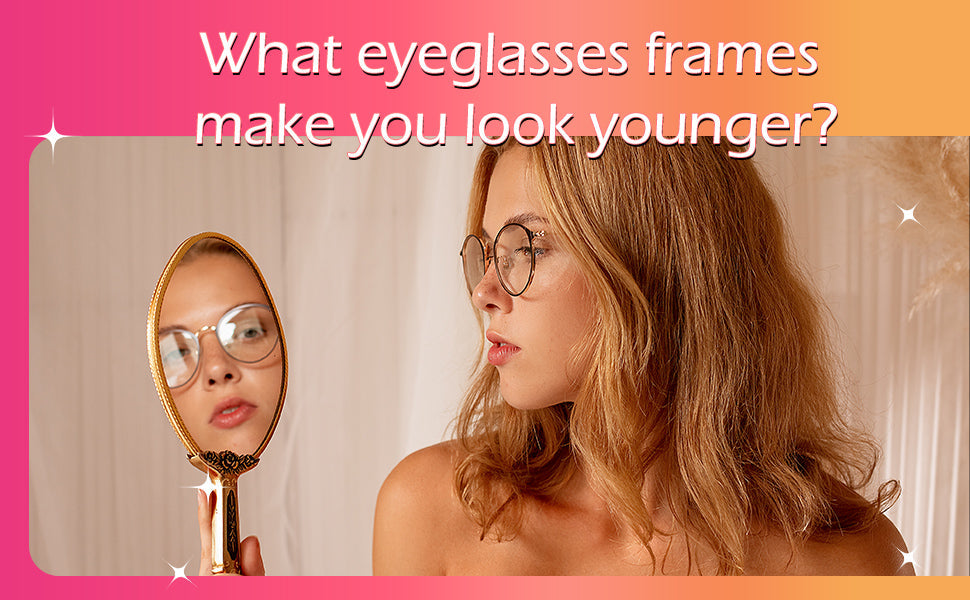
What Are Purple Tinted Glasses For?
While some say purple tinted glasses filter harmful blue light from digital devices and UV radiations from the sun harshly hitting the eye, some wear them to make a fashion statement. For some, it is for enhanced color perception because they feel it makes their vision more vivid.
Do purple-tinted glasses actually protect against harmful radiation? What is the significance of purple color in the fashion world? Can a purple tint give the same benefit as in a room and while driving or snow skiing?
The fact is that there is much more than what you see as a purple color on the lenses. This attributed "color" is neither a simple coating nor the lens's hue just to appear purple. The surface of the lens is layered with an anti-reflective coating. When light reflects on the lenses, it displays the color of the coating.
This means there is a sophisticated process behind coating the lenses and a deliberate purpose to do so. Let’s understand what purple-tinted glasses are all about.
- -What is the Purpose of Tinted Glasses?
- -How Do Tinted Glasses Work?
- -Is Purple Stronger Than Other Colors?
- -Do Purple Tinted Glasses Cause Side Effects?
What is the Purpose of Tinted Glasses?
You may agree with what any ophthalmologist says UV protection matters more than the lens color. The primary purpose of the tint is to minimize diffraction from the lens surface and allow more light waves to flow through the lens rather than reflect off it. This removes sight distortions and improves visibility.
Interestingly, it is the coating that shields your eyes that gives the colored tint when light hits on the lens. So, it serves both the purpose of protection and style. However, not all color provides the same protection on all occasions. Each color has a specific wavelength and filters accordingly.
The high-energy visible (HEV) or blue light and ultraviolet rays are present everywhere, but the impact depends on whether you are inside or outside. And it also depends on which part of the day you got exposed to these lights.
How Do Purple Tinted Glasses Work?
The special layering on the lenses undergoes a sophisticated process. They bond these coatings at highly precise thicknesses based on 1/4 wavelength of light at a specific angle. These processes are as per complex theories of physics called “thin film optics”, involving how light behaves in “thin films”.

The thickness of the anti-reflective (AR) coating on the lens is what makes the variations in color. Most lenses have a greenish tint, but some are blue-purple though. The green reflections are usually from superior-quality coating materials, such as Crizal.
This coating, Magnesium Fluoride, is a metal, sprayed onto the surface at a pre-defined thickness. Over this metal coating, a layer of Teflon is applied on it to make it smooth to conveniently clean smudges or remove dust, etc.
Quality coatings are expensive but last longer, whereas bluish tint is usually made of inferior material and has a shorter life.
Is Purple Stronger Than Other Colors?
Your work and recreational activities define the type of glasses you need and the tint it requires. Some colors may be counter-productive instead of enhancing the vision. Polarized or mirrored glasses are suitable for high-glare environments like skiing or rowing but do not fit in a workplace.

So, understanding your purpose and usage of your glasses first is very important before selecting the color for your lenses. Let’s briefly analyze what each color does and find out the significance of purple.
Green
This is considered the most protective color that filters the maximum blue light and UV rays. It helps reduce eye strain even from a bright glaring sun. You can use it mostly for outdoor purposes and sporting events like golf or skiing.
Gray
Gray is a neutral color mostly used for activities on the water, like fishing, rowing, or yachting. It can greatly reduce glare both on sunny or cloudy days. It is also good for driving on a bright, sunny day.
Amber or Brown
Cloudy days appear a little brighter with an amber anti-glare color. It can provide comfort for the eyes in warm temperatures and provide a contrast with blue skies and greenery. So, you can consider wearing Amber colored lenses when playing sports like baseball or golf where you need to be able to distinguish small items from distant ones.
Yellow, Gold, or Orange
If you are in a moderate to low light area, sunglasses with a tint of yellow, gold, or orange would perform well. It has good depth perception and functions satisfactorily indoors and outdoors. Although it may distort color, yellow, gold, or orange increase object visibility and makes an impression of a brighter environment while filtering out blue light.
Red or Rose
This blocks blue light when outside and reduces eye strain. It enhances driving visibility. Sunglasses with red or rose-colored lenses are excellent for wearing during athletic events and skiing, as they assist expand your field depth and enhancing detail.
Blue or Purple
Blue or purple-tinted glass lenses offer spectacular and improved color perception. Besides providing protection from shiny surfaces, particularly snow, they also make it easier to perceive the contours around objects. Purple lens sunglasses are also effective in cloudy and hazy conditions. Additionally, they complement practically any skin tone well.
Purple may not be the best option for all conditions but has a wider acceptance in terms of style and function.
Do Purple Tinted Glasses Cause Side Effects?
Many of us are complacent about eye health and visit the ophthalmologist only when we need a new set of glasses. We are so wrong in that assumption and should essentially make a yearly visit to an eye doctor. There could be an underlying medical condition that needs treatment before you decide to change your glasses.
The digital devices we are so used to being one of the major sources of causing eye ailments. The Blue Light emitted from these devices has deeper effects than we know. But as soon as we realized its harmful effects, we came out with blue-blocking glasses to our rescue.
These glasses used globally now claim to help reduce the risks and negative effects of excessive exposure to this sort of light. Yes, it does, but how much and aren’t there any side effects?
In particular, when gazing at a screen for extended periods, working at a desk might cause headaches. Blue light may also cause migraines, blurred vision, fatigue, and skin damage, headaches.
If you are looking at the computer monitor for longer durations, then these purple-tinted glasses can be of little help. You are merely adding a layer of plastic between your eyes and the screen. And that might just aggravate your headache from eyestrain.
Does that mean purple-tinted glasses are practically useless for protection but just good to make a fashion statement? Not really. Purple-tinted glasses do their work to protect your eyes from this harmful light; but not entirely. We cannot blame the tinted glasses for that. You need to take adequate precautions to remain protected.
American Optometric Association encourages employers and employees to make eye health a priority and implement five simple tips in their offices.
Follow the 20-20-20 rule a few times a day.
Keep a comfortable distance from the computer monitor of at least 24 feet.
The viewing distance should be 4 to 5 inches below eye level, as determined by measuring from the center of the screen.
Reduce the amount of light reflected from the screen and the intensity of glare from other light sources.
Make an effort to blink frequently.
Conclusion
To some, the purple-tinted shimmering glare is cool. The quality of the anti-reflective coating determines the color of the light reflection. A blue or purple layer contains six layers, whereas a green coating has nine. We recommend a thicker coating for those who drive at night and spend a lot of time on the computer. These colored lenses do not affect the visual quality and are just cosmetic adjustments.






